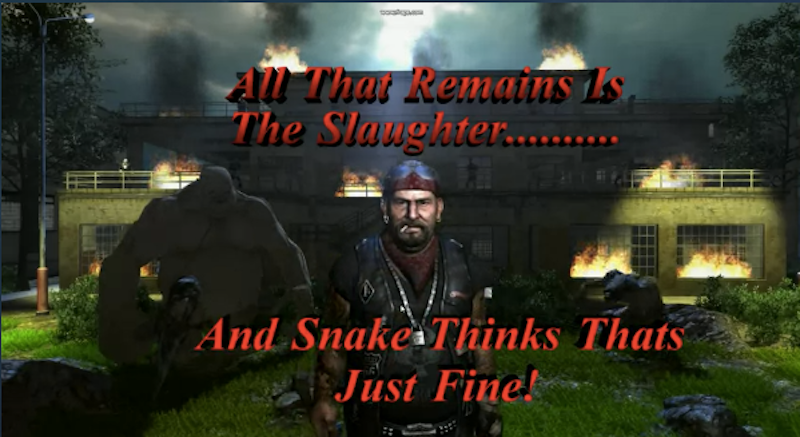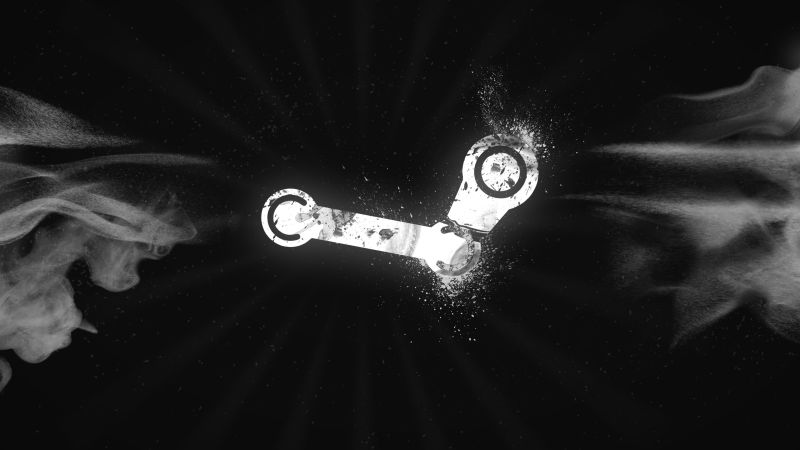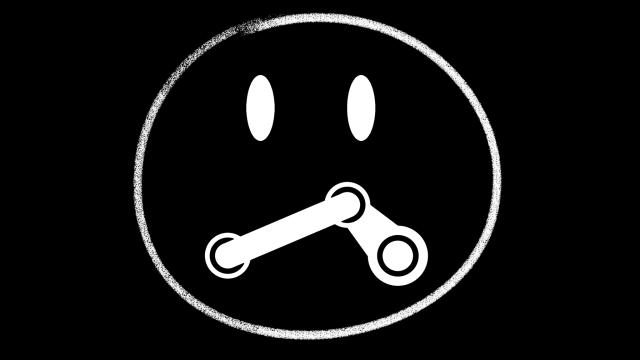It’s been a dramatic handful of days for Steam. Infamous shovelware developer Digital Homicide Valve booted them and all their games from the service. The worst part? This was all painfully avoidable.
Art by Tara Jacoby.
The Digital Homicide situation is the culmination of Valve failing to address critical issues in Steam. Namely, an endless flood of crappy or sketchy games through services like Greenlight and Early Access, and a lack of strong anti-abuse tools for developers and users. These problems make life more difficult for users and developers on a daily basis, and they communicate this frequently. If Valve put more time and resources into curating and moderating, they could likely stem the tide, if not solve the problem.
Despite that fact, Valve typically says and does very little — at least, until somebody sues.
Steam, while still obviously functional and stocked with a ludicrous number of great games, is a systemic mess. It’s a cluttered amalgam of disparate parts, some automated, others meant to be driven by a steady human hand. Many of them have been at odds with each other for years. Steam is an “open” platform, except where it’s basically the opposite.
It’s a labyrinthine game library rich with history, but new crushes old on a daily basis. It’s got discoverability algorithms, but they’re powered by user-driven systems like reviews and tags, creating a system many developers feel like they have to game in order to succeed.
It’s marked by a hands-off approach from Valve, except when they drop in with huge changes they haven’t previously communicated and make people panic.

The key problems that brought us to this point, though, can be simplified to the following: 1) Valve refuses to curate Steam in meaningful or consistent ways (except when things reach a breaking point and the damage is already done), and 2) Valve allows and systemically endorses Steam users to behave in ways that are toxic, verging on abusive, with developers and each other.
These two problems — while not causally intertwined — are absolutely related. And they tend to pit Steam users and developers against each other, even when they ostensibly want the same thing: to buy and/or sell games they have a personal interest in. That’s a sad, ultimately destructive culture clash, the last thing somebody who runs a game platform should want to foster. And yet, Valve, by being so hands-off, has allowed it to fester, and they show no apparent concern for the growing hole in Steam’s heart.
Let’s start with the first thing, the bit about curation. Once upon a time, Steam’s game selection was entirely curated by Valve. Now it’s split between quiet approvals directly from Valve (mostly for bigger publishers and studios that have already had good success on Steam) and Steam Greenlight. Steam Greenlight allows users to vote on games they’d like to see on the Steam store, but Valve ultimately has final say. Used to be, Greenlight was far from a surefire ticket into GabeN’s hallowed halls. These days, though, automation lets a lot of crap squeeze through the cracks.
With crap and, increasingly, some seriously sketchy stuff gumming up Steam’s works, it’s no surprise that Steam users are upset. Things appear to be getting worse, not better. With no alternative option available and little in the way of words from Valve (except, of course, a tangle of partially user-driven systems that implicitly say, “You have power. You should be in control”), some have taken it upon themselves to police Steam.
That’s where you get groups like the Anti-Consumer Practice Report, the Framerate Police, and one of Digital Homicide’s main targets: a Steam group called, well, the Digital Homicides.

While not in possession of a spotless track record, the Digital Homicides’ goal is to clean up Greenlight. They do this by keeping tabs on developers and games they view as questionable, pointing members in their direction for the purposes of reporting them or otherwise warning people away.
And so, in Valve’s absence (beyond inconsistent reactions to reports), that’s what it comes down to: groups/users that want to police Steam versus developers. Slowly but surely, the opposition has become toxic. Many of these groups and individual users begin with good intentions (and the Digital Homicides’ leadership certainly tries to keep people from being out of line), but in loosely affiliated groups with thousands of members that have no means of imposing strong consequences on shitty behaviour AND very little intervention from Valve, there’s gonna be bad apples — people who go into forums and comment sections and spout hateful, sometimes threatening language or dig into personal details.
Whether acting as part of a group or alone, some of them are jerks, but for others it comes from a place of self-righteousness. They feel they’re doing The Right Thing, even when some of their behaviours verge on harassment or abuse. It gets even worse when developers block or ban them, which they take for a sign of wrong-doing on the developer’s part when, sometimes, the developers have been dealing with so much toxicity that they just can’t handle it anymore. It shouldn’t need to be said, but developers are people too.
However, people then ring the rusty old “censorship” bell, at which point more toxicity is inevitable. And sure, sometimes developers are trying to bury skeletons intrepid Steam users yanked out of their closets, but that’s certainly not true all the time.

It gets tough when you consider the broad spectrum of people submitting games to Greenlight. Yeah, some of them are sketchy, or they have just taken a Unity asset pack and slapped a new name on it, but others are well-meaning (albeit under-qualified) hopefuls.
Heck, I’ve even seen a handful of people who were pretty obviously kids posting their first cracks at game development to Greenlight. Should you try to sell that on Steam? Probably not. Do you deserve to be met with tens or even hundreds of nasty messages for that naive transgression? It’s overkill, the sort that sticks with some poor kid for a long damn time. But as soon as an “us versus them” mentality enters any sort of picture, so too does a tendency to paint many different people with the same brush.
The bigger issue, though, is that none of this is very effective, nor is it, you know, a good thing to do. It’s just the only thing that gets a reaction, that feels like it produces an effect on Steam.
However, the angry mob approach often inspires unhinged behaviour in at least some of the people involved, and it doesn’t keep the Sketchy McSketchertons of the world from doing their thing. They just re-submit their games on Greenlight, or they strike up promotion deals with massive giveaway groups to get a glorious golden shower of votes.
The actual Bad Ones don’t care if you like them. They just care that they’re making money.
And they do make money. Releasing bad games by the grimy, maggot-infested fist-load on Steam is a viable business strategy. See, there’s an entire secondary market for Steam trading cards, emoticons, backgrounds, and things of the like. Developers get a ten per cent cut of each transaction on those items, which usually translates to a few cents per transaction.
However, those items are sometimes sold hundreds of times per day. It adds up. Moreover, people will often buy low-priced, crappy games and then use programs like Idle Master to get cards without playing. Some even sell those cards to turn a profit. So they have an incentive to, say, buy a $US3 ($4) bundle that includes all 21 of Digital Homicide’s games. As Tarmack points out in this excellent, data-backed video, it’s very likely that these practices played a big role in Digital Homicide’s business strategy:
And what does Valve do about these exploitations of the systems they have made? Nothing. Or at least, nothing that prevents them from continuing to happen. At the end of the day, Valve is profiting from these borderline-illicit enterprises, and whether they’re wilfully allowing the garbage parade to run rampant or they just don’t give enough of a shit to take a closer look, Valve takes a cut of these transactions, too. We can’t ignore that fact.
All that in mind, it’s not really surprising that many hardcore Steam users are intensely distrustful of developers. They know about this stuff, or they have heard bits and pieces of it secondhand, or their friends recount larger-than-life exaggerations that were never true in the first place, but a friend told them so why wouldn’t it be true?
Which brings us to the other side of the coin: Steam developers often face audiences who are hostile by default. Honest mistakes, or tough creative decisions, or chaos born of that un-wrangle-able bull known as Game Development — these things are interpreted as signs of purposeful malice, and massive-scale rage often follows. Sometimes it’s constrained to Steam reviews and forums.
Other times, it leaks out to Twitter and other social media. Digital Homicide, awful though they were, claimed they even received a bag of faeces in the mail.

What do developers have to mitigate this? A slim selection of moderation tools not unlike what you’d find in a regular Internet forum, as well as the ability to flag off-topic, scammy, or harassing reviews in hopes that Valve might do something about them. But when you’re dealing with hundreds or thousands of people, that’s a cold comfort — especially in an environment where, again, moderation frequently gets conflated with “censorship” and leads to more trouble.
It’s not difficult for especially troublesome Steam users — say, those who want to repeatedly harass a specific individual — to make multiple accounts and just swap between them as soon as one gets banned from a game’s forum or blocked by a user.
It’s almost funny to me that, nestled beneath a picturesque mountain of bullshit, the Digital Homicide guys had one good point. They were vile arseholes, no doubt, frequently stoking the flames and doing crappy things to Steam users. They and their games were all too worthy of criticism, and they got a lot of that. But I don’t think they deserved the abuse they also got. Because the truth is, nobody does.
It’s a mean-spirited, under-handed tactic, and it rarely convinces anybody to change. Instead, in the face of mass-rage, people either dig their heels in or flee. Neither of those are good outcomes.
Valve could’ve done any number of things to prevent this. They could’ve curated Steam slightly more carefully to keep such obviously terrible games out, to avoid the junk pile-up Steam now contends with on a daily basis. They could’ve intervened when it became obvious that Digital Homicide was a toxic presence possibly exploiting their systems to turn a profit. They could’ve offered developers and users alike better tools to mitigate toxicity, abuse, and harassment and taken an active role in fostering a less mean-spirited culture. They could’ve seen the false opposition between Steam users and developers for the ticking time bomb it is.
They could’ve tried to dismantle it.

Instead, it detonated, and a bunch of people got sued by two crackpot brothers who shouldn’t have ever had games on the world’s most prestigious PC gaming service in the first place. And the worst part is, there’s not really anything to stop something like this from happening again in the future, nor is there any sign that Steam will become a better, less hostile place for users or developers.
I’m not saying Valve is solely to blame for all of this. There are always gonna be some crappy people, regardless of how many steps you take to safeguard against them. Valve, meanwhile, does have people watching over Steam, and they do sometimes step in and take care of problems before they go nuclear. They have even been doing a slightly better job of communicating lately, which gives me a small sliver of hope.
But I am saying that you can’t just build an “open” platform and then abstain from responsibility when your systems give way to abject ugliness. It’s not simply the fault of toxic individuals or groups. It’s also the systems surrounding them, as well as the underlying choices, priorities, and beliefs that went into the creation of those systems.
At some point, you’ve gotta do something to course correct. You’ve gotta make things better instead of allowing them to keep deteriorating. You’ve gotta step in before the breaking point, not after the damage has already been done.
Steam has a sickness, and Valve is, at this point, the only one who can cure it. In the wake of the Digital Homicide fiasco, I sincerely hope they re-prioritise, and I hope they do it fast.

Comments
33 responses to “Steam’s Digital Homicide Fiasco Is Valve’s Fault”
*Partially* steams fault. I know you acknowlege this but only right at the end almost in passing. Lets remember DH (How suiting it comes down to dh) still set out to intentionally create dodgy games to exploit Steam in order to rip people off willingly. Yes Valve should curate better but dont forget theres personal responsibility here and DH ARE just as reaponsible for being scummy con artists.
This is faulty logic, of course. Valve allowing D-grade games on Steam is a separate issue to whether a developer loses their shit, attacks users and tries to sue everyone.
Developers already have direct moderation tools for their games’ discussion board. You can’t give them direct moderation tools over reviews of their own game, it violates the integrity of the system. Some developers have shown time and again that they will censor dissenting discussion threads, what do you think will happen if you let them moderate reviews as well? Guaranteed in less than a week there’ll be a story about how some developer has abused the tools to squash criticism and make their game look like it has a higher rating than it does. The entire point of the review system is it’s completely out of developers’ control.
Devil’s advocate for a moment: From what I’ve read, they weren’t asking for direct moderation of their own reviews, they were asking Steam to moderate abusive or threatening reviews. When Steam failed to do so, they sued.
Disclaimer: This does not in any way excuse the piles of shit that they released, and legitimate negative reviews should always stand.
I’m not sure what DH asked for, I was referring more to Grayson’s complaint that they should have better moderation tools available to them. Reviews are an area you absolutely don’t want developers moderating themselves so I’m strongly opposed to that notion.
admittedly a lot of the abusive and threatening reviews come from those giving negative reviews, so it’s a bit tricky as far as I see giving them any sort of ability. Some people only know how to express themselves from a perspective of anger and more often than not it comes a lot much harsher and more personal than they may have intended when they’re just trying to colourfully illustrate their point.
I dunno, I tend to think that if can’t articulate a criticism of a game without telling the developer to kill themself, or insulting their mother, your review should probably be excluded anyway.
The review content yeah, the review score, no.
So they claim… but they’re the same team who wanted to sue Jim Sterling for 10 mil. It seems like this is their go-to response, like they’re Scientologists or something.
Yeah, I don’t know if I could suggest that if Steam *had* just deleted abusive reviews that they then wouldn’t have have found something else to sue about. Still, Steam should do something about abusive reviews.
True – Steam should do something about a lot of things, unfortunately.
Problem is that people have different versions of what is abusive. I’m part of a game dev site and we have inbuilt reviews (which are sorted through by hand, having to be manually accepted) and we get some people who blow up over the meekest of critiques. Tell someone that their maps are a bit bare, that their level design doesn’t make sense, that the game is buggy or too hard or unbalanced and they blow the stack.
Some people are just incredibly thin-skinned and we’ve manned many reports of abusive reviews, only to find that the review in question is well-written, unbiased and really good advice for the creator. You just can’t win when people are -determined- to make noise, for whatever reason.
One example I’ll always remember is a review that was written on a demo of a game. The creator screamed about how horrible the review was and how it didn’t count because the writer only took 15 minutes to play the game, total. They demanded that playtesters found it much, much longer and that the reviewer didn’t play long enough to give a review. I stepped in and played the game. Took me a little less than 15 minutes, and I had enough time to die once and have to restart during that time. Eventually they were banned from the site for breaking other rules, but they made such a fuss over the review (which was actually complimentary in places, even if it did point out a few things that really needed fixing).
Hell, I pointed out a game that used edited rips from a PS1 game on steam and the creator kept deleting my topic. So I played the game and wrote a very comprehensive review. They didn’t like that and tried to flag it for abuse. Of course, it didn’t win, so they then called their friends in to downvote it over and over and argue through the whole thing. The game is still on Steam, it still has the ripped graphics, despite being reported (really wish Steam would fix that area up, actually) and it’s still for sale.
Counterpoint: no it isn’t.
Steam has issues with curating content but they didn’t force Digital Homicide to make shitty games then act like victims when people pointed that out.
Negative reviews != abusive reviews
As I said above “if [you] can’t articulate a criticism of a game without telling the developer to kill themself, or insulting their mother, your review should probably be excluded”
It’s the iTunes of PC games.
Those of us old enough to remember what it was like before Steam shudder to think of those times, but the publishers which ruled the roost were both a blessing and a curse.
The worst possible outcome here would be those same publishers continue to pull their games (or their upcoming stuff at least) off Steam and continue offering their own alternative shop-fronts. More fragmentation is probably inevitable.
I loved the pre-Steam days. In fact, Steam is a big part of the reason I’ve now jumped ship to PS4 for most of my gaming.
Really? Half my game catalogue wouldn’t have existed in the pre-steam age
Smaller, cheaper titles that I can knock over in under 10 hours
Maybe because I’m less focused on AAA titles these days and prefer a wide range of different ones
Indie games have always existed, and been distributed.
Steam was a huge step backwards from people being able to go into bricks and mortar stores and being able to buy a physical game to have and run, as opposed to needing to download from the modern equivalent of a BBS. It let publishers shave costs by just distributing glorified steam installers on a disc or just having a store code. Or just having broken unfinished games on the disks that require day one patching to be in a playable state.
While it’s good that other digital distribution sites are rising gradually to break Steam’s monopoly on digital distribution, the only pro-customer moves Valve has done has been after a country’s government has dragged them kicking and screaming to court over their practices.
Indie games have existed but without a centralised site for discovery they have never been easily purchased.
As for bricks and mortar stores your memories of that are very different to mine. Without the competition you were lucky to be able to find the game you wanted due to the limited range of PC games. And if you did find something interesting it was still being sold at full retail price 3 years after release.
I don’t have an issue waiting for a game to download but that is me and understand that other people do things differently. But being able to see a game, buy it and install without leaving the house is a great thing for me.
As for the broken game thing, that is the same on console or retail purchase. So not sure that steam is the culprit here, unless you mean they normalised digital distribution meaning publishers can assume people have an internet connection to update.
As for pro-consumer you can’t overlook the fact that steam normalised deep discounts in an industry that never previously had them. That is pretty damn high on the pro list for most consumers.
My thoughts exactly
Article suffers from being an incoherent rant.
Next time, more facts, less emotion.
Comment suffers from logical inconsistency.
If facts refute the central premise of the article, why should more be included?
“However, people then ring the rusty old “censorship” bell, at which point more toxicity is inevitable.”
This one line gives so much away about where the author is coming from. He wants to be able to physically stop people from being mean, hence the story of the kids who made a game and got canned.
“Steam is at fault because they are too open to crappy games and don’t curate their library well enough” hmm….. it feels to me that the author is using the same argument as that used when idiots say “women who get raped are at fault when they dress provocatively and don’t take better action to protect themselves” – When in actual fact the fiasco is Digital Homicide’s fault for making shit games. It seemed to me that Steam gave the power of curating the games library to the people because there’s that many developers who want to release that many games on Steam’s platform & as such the amount of effort required to manage this would be terribly overwhelming.
Unfortunately the situation eventuated that Digital Homicide’s games were shit & they reacted incredibly aggressively which is a terrible way to conduct business in general, tbh. Trying to moderate their own reviews and then attacking the individual users was only ever going to exasperate the issue when instead they should have taken the negative feedback on board & try to do better. Many other studios are able to do this in order to improve their product so DH have no excuse, in my opinion.
Actually the rape victim blaming analogy fits better to your comment. Digital Homicide do create shit games, but does anyone deserve tirades of abuse, doxxing, death threats or nasty bundles in the mail? Where is the community’s responsibility to acting like human beings instead of animals? DH certainly does deserve criticism, but the reaction of some parts of the community goes well beyond just criticism … especially when you can just get a refund and move on.
I’m going to argue a weird point here.
DH have a right to make shitty games.
I have the right to play their game and say this is shit, it looks like they purchased some asset packs for Unity and rolled dice on what to add to the game.
People have the right not to buy those games. If you think something isn’t worth the price don’t buy it.
What isn’t Right is me to add a death threat at the bottom, or dox them or pursue them on Social Media or form a Cyber Lynch mob.
It also isn’t right for them to attack my honest review of the game, but I remember the Youtube thing with Jim Sterling I saw where he was arguing that he deserves a good review for his shitty games because he used professional assets and he made something, and deserves as much praise as somebody who made something good, unique and amazing.
I think the biggest problem with the internet is people are Anonymous, and that’s mostly a good thing. It protects us from the crazies who will track you down for a difference of opinion. But it also allows people to say things they would never be able to say face to face, or in a room of random people.
I try to make sure everything I say online is something I would say in public and to somebodies face. I don’t have to agree with what you say, I just have to be respectful and let you say it.
Sure Value is no innocent party but I am sorry Digital Homicide ‘devs’ (in the absence of a better work or else I will get sued as well) are the ones who have been pedalling trash for years. Even if you only take a half or even a quarter of everything Jim Sterling has ever shown us and other content creators, as true. They are terrible. The games and their customer service is deplorable. That is their choice, no matter what Steam did along the way or whatever they could have done to make their side of things better, ultimately these devs decided what level games they wanted to make. That is on them.
Personally I find it sad what STEAM has become. Gone are the days of looking at the homepage once a day to see what sales suddenly, now it is just a cesspool of cheap crappy games and angry entitled gamer reviews that say more about having goes at devs for bad decisions than actually reviewing games.
but Digital Homicide seemingly didnt want to put the hard yards in like so many game devs before. Raise money, invest etc. instead they set the bar low and when that back fired they are now seemingly trying to make money the only other way they know how, sue. Sueing makes it seems like they dont want to take responsibly for their own short falls but trying to pass the blame on to the Jim Sterlings of the world (he was just reporting what he saw was happening, sure maybe sometimes crossing lines a bit). Steam (who just gave them a place to live but didnt rein them in when they should have). The Customers (who were just being customers).
Part of the problem here is that valve was seen as such a silver bullet / cash cow that when they did a stricter job of curating greenlight and limiting they coped a heap of abuse/complaints from devs who believed they had the right to be on steam and how come x game got through but mine hasn’t yet.
This made developers happier but was worse for consumers as low quality products made it through. However more niche titles made it through which is good for people who like that kinda of thing.
As for the users being nasty, no platform has the ability to limit that. Just search “Kill yourself” on twitter if you need that driven home. How can a platform that allows user comments be able to police everything that is said. It is totally unfeasible.
Yeah, I definitely remember the days of seeing bleeding-heart articles on various sites asking why certain indie darlings didn’t have their ‘inspirational’ titles turning up on the Guaranteed Big Money Payday that was Steam at the time, and after checking out those titles, the only reason I could see was… those titles were crap that I’d never buy.
But apparently that wasn’t an acceptable answer, and now we have Steam turning into the iTunes app store of game distribution.
And now that they’ve got their way, that noisy crowd of oh-so-special indie darlings is bitching about how they can’t stand out from the crowd any more (UTTERLY blind to the fact that they are the crowd), that just ‘getting onto Steam’ is no longer the guaranteed payday that it used to be when ‘not just anyone’ could get onto Steam.
There’s only so much you can read of it before it all starts sounding like, “WHY DOESN’T ANYONE REALIZE THAT I’M SPECIAL AND MAKE ME RICH FOR IT?”
That said, I prefer the way Steam runs now to the way it ran then. Back then, Valve were the sole curators of the system and only what they approved was available. Now, the curation is done by users within the system rather than by omnipotent outside force, and the platform has a lot more options. It’s gone from ‘only what we like is available’ to ‘everything is available, and here’s what X likes’ where X is any number of people you choose to trust. More curators means more differing tastes represented, and more available on the platform means more choice. Both good things.
“those titles were crap that I’d never buy. […] and now we have Steam turning into the iTunes app store of game distribution.”
This is a bit unrelated, but it’s funny to notice that this titles are the bulk of what PC “Master Racists” tout as “hundreds of PC exclusives”.
Good article. You have summed up a lot of Steam’s issues and have put forward some reasonable arguments. I agree that system design (both intentional & oversight) goes a long way to explaining the culture of the Steam community on both the developer and consumer sides. Fix the system and you remove the incentive for people to behave in such horrid ways.
I get what the article is trying to say, but the argument reminds me of when people say “why is there violence / wars in this world?! why doesnt everyone just stop fighting?”. Violence / toxic comments on the internet are part and parcel of the human condition, sure it sucks, but i don’t see it going away any time soon. The articles ‘think of the children’ rant seems nieve to me and for me, and was less to do about DH and more just wanting to criticise Steam
This might tick some off, but TBH i dont really care about all the shovelware on steam. I have a good handle on what i like, i know what’s good (thanks to youtube and sites like this) and the hive mind mentality of the top sellers list helps me know what’s trending – shovel ware never fills up this list, and until it does i couldn’t care less. For me steam is just fine the way it is.
Maybe DH does not deserve all the crap its getting (literally) – but i like a good story and when the despots of this world get taken down a peg
This is like saying that Capitalism is to be blamed for white-collar thieves. A system only provides opportunity and there will always be crooked people finding the ways to get more for less and eventually ruin it for everybody. If Steam was a “perfect” platform where what DH does is simply not possible, you can be sure they (or people like them) would find a way to exploit some other feature.
Steam’s fault? Hah. Yeah sure, they could moderate more? but honestly, good to see the guys gone off steam and their shitty games too. I RECCOMEND to the writer of the article to go and listen to Jim’s discussion with the so called “GUY” from Digital Homie Cide. He’s an arrogant prick who thinks even fair criticism is harassment. ANd for that matter everyone who sides with digital on this can go f themselves with them.
Well ultimately players decide if a game is good or bad and sometimes they decide its utter garbage and hammer the developer for it. If developers are going to get mad for making bad games then people trashing those games they should either grow up and take it as constructive feedback or not sell there games on steam. Steam review system for the most part is fine it allows people who purchased the game to give there opinions and for the most part i think atleast at a minimum 80% of people who buy those games give honest opinions about them. moderating it is a waste of time and makes it easier for developers and publisher to get away making broken, bad or unplayable games.
What I want to know is, who is buying the Steam cards from games that nobody plays because they’re so crap?
What a nice opinion piece 🙂
Gee I remember when back then we had Newgrounds, and we were all kids submitting our crappy flash games, and it they were bad, we SURELY were bombarded by nasty comments and we all turned out better people because of it. I hate the mentality of “everything is offensive!” of today’s population.